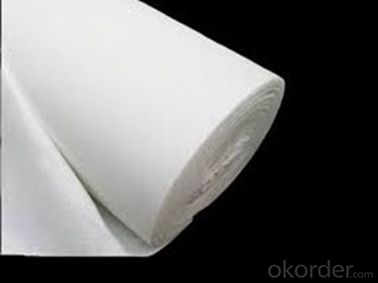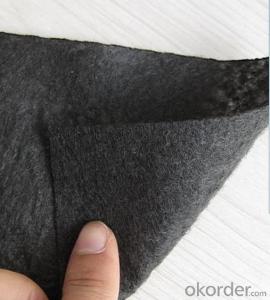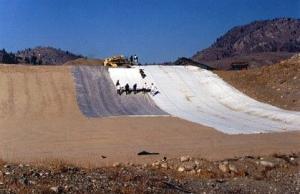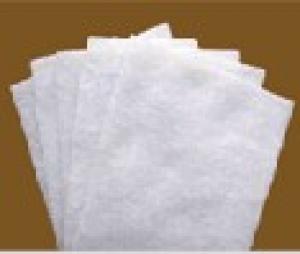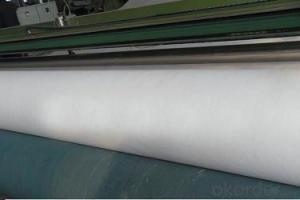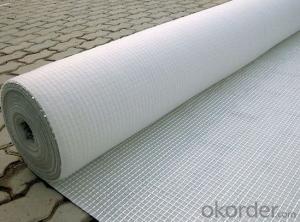Terram 1000 PP Nonwoven Geotextile Fabric Reinforcement and Drainage CNBM
- Loading Port:
- China main port
- Payment Terms:
- TT OR LC
- Min Order Qty:
- 4000 g/m²
- Supply Capability:
- 1000000 g/m²/month
OKorder Service Pledge
OKorder Financial Service
You Might Also Like
Specification



Product Description
1. short fiber needle punched nonwoven geotextiles (heat set or not) Pet short fiber
Geotextiles are permeable nonwoven fabrics used to separate,filter,reinforce, protect or drain.Geotextiles allow filtration or separation of granular layers in roads and rail applications,used to protect membranes in landfill applications,used in coastal defence applications and used in landscaping to protect surfaces and structures from weeds and root growth.
Geotextiles are availabel as woven and non-woven .As liner protection, against physical damage, the non wovens are normally the answer.They are made up of fibers of polyester or polypropylene in random directions and punched together by needles during the manufacturing process.Geotextiles are commenly used to separate layers like clay and drainage and to protect liner from damage.
FAQ:
Q: What kind of payments does jenor support?
A: T/T, L/C, Cash are accepted.
Q: Do you charge for the samples?
A: Accordeing to our company policy, the samples are free, we only charge the freight fee. And we will return the freight fee during the next order.
Q: Can you produce according to customers' design?
A: Sure, we are professional manufacturer, OEM and ODM are both welcome.
Q: Do you have other products?
A: Yes, please check the pictures:
Packaging & Shipping
Packing: PLASTIC FILM INSIDE, AND WOVEN BAG OUTSIDE
Shipping: About 15 days after receipt the deposit
Quality assurance
1.On a regular basis or as per your request,we entrust national testing agencies to conduct quality inspections
2. Strictly in accordance with the ISO9001-2008 international quality system standard,we monitor and manage the whole process throughout production,quality testing,and measurement to ensure product quality
3. For quality-related construction delay or substandard construction(except for damage or losses due to customer’s responsibility or irresistible natural disasters),we have refunding,replacement,and repair services.We will respond to customers’ feedbacks on quality issues within 24 hours.
- Q: Is the filament geotextile the same as the tensile strength of other acupuncture nonwoven fabrics?
- 1, polyester filament acupuncture non-woven geotextile pet.15-6-300, is the national standard filament geotextile, the material for the polyester polyester (PET), the unit area of the quality of 300g / ㎡, the breaking strength of 15KN / m in line with GB GB / T-2008 standard 300g / ㎡ filament geotextile requirements. Polyester filament acupuncture non-woven geotextile pet.15-6-300 product width of 6m, 6m wide polyester filament geotextile is a more conventional products, manufacturers can directly produce 6m wide polyester filament Geotextile. 1. First geotextile polyester staple fiber geotextile (PET) and polyester filament geotextile two. The physical tensile strength of the two geotextiles is different. 2. Polyester staple geotextile according to the national standard GB / T-2008 standard implementation, 400g GB polyester staple geotextile physical tensile strength ≥ 12.5KN. 3. Polyester filament geotextile in accordance with the national standard GB / T-2008 standard implementation, 400g GB polyester filament geotextile physical tensile strength ≥ 20KN. 4.400g GB polyester staple geotextile longitudinal and horizontal tear strength ≥ 0.33KN, 400g GB polyester filament geotextile longitudinal and horizontal tear strength ≥ 0.56KN.
- Q: What are the different applications of geotextiles in agriculture?
- Geotextiles have various applications in agriculture, including erosion control, soil stabilization, weed suppression, moisture retention, and filtration. They are used as ground covers to prevent soil erosion caused by wind or water, providing stability to slopes and embankments. Geotextiles also help in retaining moisture in the soil, reducing the need for irrigation. Additionally, they act as a barrier to control weed growth, reducing the competition for nutrients and water. Furthermore, geotextiles are employed for filtration purposes, allowing water to pass through while preventing the loss of fine particles. Overall, geotextiles play a crucial role in enhancing agricultural practices and promoting sustainable farming.
- Q: Can geotextiles be used in erosion control mats?
- Yes, geotextiles can be used in erosion control mats. Geotextiles are often used as a component in erosion control mats to provide reinforcement and stabilization, helping to prevent soil erosion and promote vegetation growth.
- Q: After the laying of drainage board and then need to lay a layer of geotextile it?
- After the laying of drainage board and then need to lay a layer of geotextile it?
- Q: Can geotextiles be used in mine tailings dam construction?
- Yes, geotextiles can be used in mine tailings dam construction. Geotextiles are often employed as a barrier or reinforcement material to enhance the stability and performance of mine tailings dams. They can provide effective filtration, separation, and erosion control, helping to improve the overall integrity and environmental sustainability of these structures.
- Q: Do you want to use glue to connect the geotextile?
- Hello, geotextile is not glue to connect, with needle and thread stitching, the request is not too high, but also intestinal smooth spot heap stupid do not need to stitch, as long as take the lead, put up on it.
- Q: How do geotextiles contribute to slope stability analysis?
- Geotextiles play a significant role in slope stability analysis by reinforcing the soil and enhancing its strength. They are used to stabilize slopes by adding tensile strength, reducing soil erosion, and improving overall stability. Geotextiles act as a barrier, preventing the soil particles from washing away during rainfall or other external forces. This helps to mitigate potential slope failures and allows for more accurate analysis and assessment of slope stability.
- Q: Can geotextiles be used in soil erosion control on construction sites?
- Yes, geotextiles can be used in soil erosion control on construction sites. Geotextiles act as a barrier that prevents soil erosion by stabilizing the soil and allowing water to drain through while retaining sediment. They are commonly used in construction projects to protect slopes, control sediment runoff, and promote vegetation growth, thereby reducing the risk of soil erosion on construction sites.
- Q: Are geotextiles resistant to hydraulic shear stress?
- Yes, geotextiles are generally resistant to hydraulic shear stress. They are designed to provide stability and prevent erosion in soil and other hydraulic environments.
- Q: What are the different geotextile installation techniques in separation?
- There are several different geotextile installation techniques used in separation, including direct placement, trench installation, and overlapping. Direct placement involves laying the geotextile directly on the ground surface, while trench installation involves placing the geotextile in a trench dug along the separation area. Overlapping is another technique, where multiple layers of geotextile are overlapped to form a continuous barrier. These installation techniques help to prevent the mixing of different soil layers and provide effective separation between different materials.
Send your message to us
Terram 1000 PP Nonwoven Geotextile Fabric Reinforcement and Drainage CNBM
- Loading Port:
- China main port
- Payment Terms:
- TT OR LC
- Min Order Qty:
- 4000 g/m²
- Supply Capability:
- 1000000 g/m²/month
OKorder Service Pledge
OKorder Financial Service
Similar products
Hot products
Hot Searches
Related keywords








